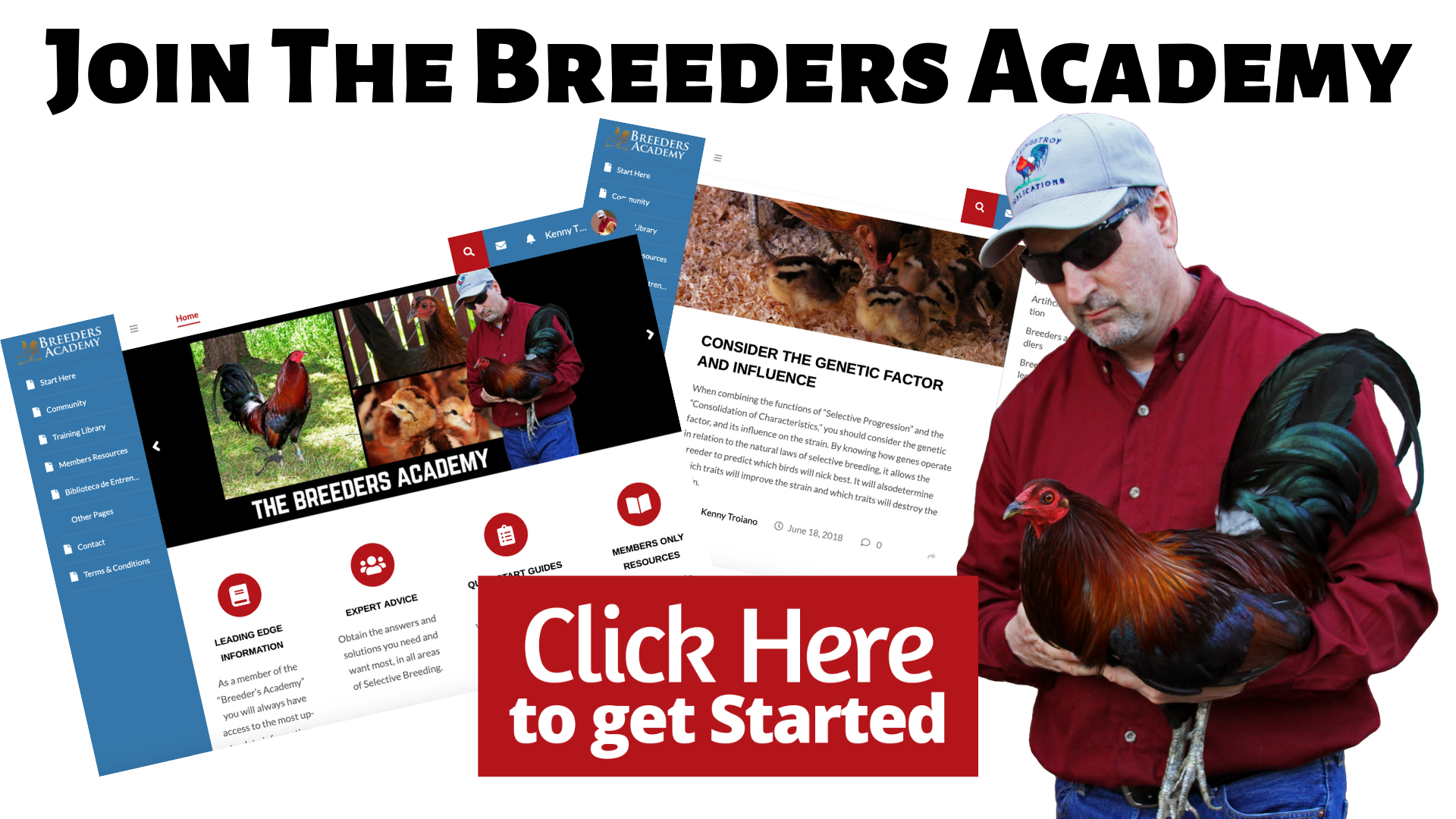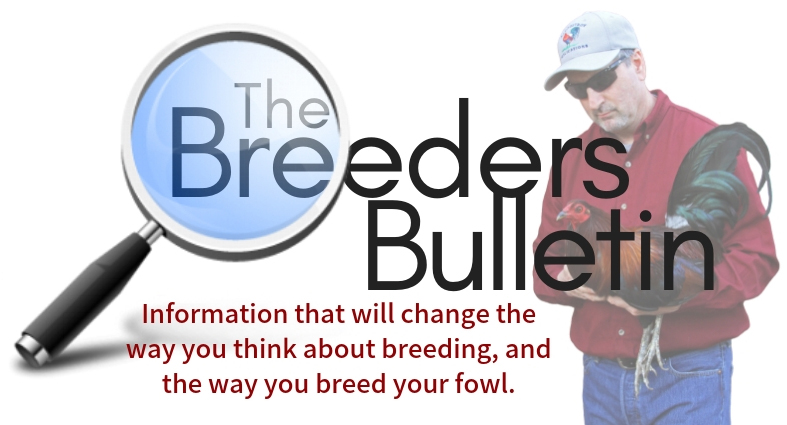What it the true worth of our modern strains, and the names we give them?
By Kenny Troiano
Copyright © 2020 by Kenny Troiano/Maximus Troy Publications
For as long as I can remember the “Name Game” has been played to the hilt. What is the “Name Game?” It’s the label sellers place on their fowl to make them more appealing to buyers. American Games have a long history of breeders who have made a name for themselves from the reputation of their fowl. Because of this their fowl have lived long after they have gone, or at least their names have.
The only problem with this is it has become a huge falsehood, nothing more than a “Big Con,” where unsuspected buyers, usually beginners, are being conned into believing that the “name” means everything.
It has gotten to the point that buyers won’t purchase fowl without the right label attached to the birds, and sellers are more than happy to oblige. For instance, if you are looking for a Hatch, or a Sweater, they have it. Or if it looks like a Hatch, then it’s called a Hatch, even though there is very little, if any of the original Hatch blood in them.
Beginners are led to believe, if a bird carry’s a specific name, then it carry’s with the name the pedigree of something special. This gives the buyer the feeling that there is a solid foundation, or strong pedigree associated with the bird for which he is buying, maybe a sense of assurance as well. But if the truth be told, all the buyer gets is a false sense of comfort, for the name means nothing.
The importance of the names we attach to our fowl: We hear a lot about “Hatch,” “Sweater,” “Kelso,” “Lacy,” and many other names of breeders of long ago, but the truth of the matter is, the fowl we have today do not bear a resemblance to the original fowl, not in how they look, nor in how they perform. In most cases, the color of plumage is the only similarity, or degree of their worth.
Gamefowl and chickens are different than most domestic animals in that we don’t have registered pedigrees. Our proof of pedigree is the name we attach to our fowl. We are forced into depending on the honesty of the breeder. This is where things get tricky. Except for a small number of Master Breeders, most modern breeders are nothing more than perpetual cross-breeders, they have mixed the bloodlines so much that the original blood is nonexistent. They may be the same color, but that’s all.
The fact is, unless our fowl are given the name of the present, most resent breeder, and I’m talking about a true “Master Breeder,” not one who introduces new blood every year, the “Name of Strains” means absolutely nothing!
Who benefits most from playing the “Name Game”? Playing the “Name Game” allows the seller to ride the coattails and reputations of breeders of long ago. Many times the reputation of past breeders is more or less fictitious, made-up or exaggerated to help boost or procure the sale of their birds. Even more importantly, by playing the “Name Game” sellers are able to distract buyers from the fact that the birds are often of poor quality.
The “Name Game” gives peddlers a legitimate place of business. It puts them on the same playing field as the Master Breeders. It allows them to breed for quantity rather than for quality. They can buy a cock from one breeder, and a hen from another breeder, cross them, and call them anything they want. Relying on the powers of hybrid vigor, they can mix and match fowl, and produce fowl that look and perform very well.
But here’s the problem, the buyer believes he is purchasing something good, and doesn’t find out the truth until he breeds them himself. Within a generation or two, what he finds is, due to the further effects of hybrid vigor, the offspring from these breeding’s are random and unpredictable. The offspring are of different sizes, shapes, colors, and performance levels. He finds characteristics and traits, such as combs types, are not as advertised. And before he knows it, he falls into the same trap as every other cross-breeder; he introduces new blood each year so he can maintain some level of performance, and soon believes this is the proper method of breeding American Games.
The only people this game benefits are the sellers. And the only way buyers can protect themselves is by not playing the “Name Game,” and learning to select fowl that have the proper form and function, including conformation of body and color of plumage, and selecting fowl that are of the highest quality. Make certain you are purchasing fowl from a reputable breeder, and not from a good breeder who only sells his culls.
By not playing the “Game” we force peddlers into becoming breeders again, or we force them out of the business of selling junk. The buyer has more control of this “Game” than he might think.
The breeder is more important than the bird: Many times we’ve heard it said, “The name of the breeder is more important than the name of the breed.” I agree with this statement a hundred percent. I think the main reason for the “Names of Strains” today is for the purpose of “proof of identity.” Most people won’t buy a bird unless there is a famous name attached to it.
About a year or so, before he passed away, I had a long talk with Mr. Allen Fisher, known as “Tar Heel. We talked about this very subject. We both agreed that obtaining a true strain is only possible if directly purchased from the breeder from which the fowl were originated. Or from a breeder who has bred them for several generations without adding outside blood. Not necessarily from the breeder who last bred them. However, we still seem to place the names of breeders, of long time past, to our families of birds. The sad thing is there are cockers out there that still believe they have birds which are direct descendants from those old breeders. I seriously doubt it?
What does it take to have fowl that are worthy of a name?
- It takes a breeder who understands the process of creating, maintaining, and improving a family.
- It takes a breeder who understands the process of “Selective Breeding.” Breeders such as this have bred their fowl for several generations. Through the process of selection they have found some variations beneficial, while culling others. In time their fowl have taken on a certain level of individuality, which makes their fowl extremely unique to the breeder.
- It takes a breeder who knows, if the offspring are not better than the parents, every generation, then they are the product of degeneration not progression.
- It takes a breeder who accepts nothing less than a family that is uniform and consistent in all their characteristics and traits. Fowl such as these have a level of quality that is matched by none.
- It takes a breeder who has fowl that are always good representatives of their breed. Their fowl have the conformation of body and color of plumage of a true American Game.
- It takes a breeder who can breed and perpetuate fowl that have the complete package. They have the form, function, and beauty of a true American Game, and they’re free from defects and serous imperfections.
- It takes a breeder who has fowl that can measure up against the best for the purpose for which they were bred.
- And it takes a breeder, when questioned about their fowl, they will always have the answers. They know everything about their fowl, and their fowl never surprises them.
Stop playing the “Name Game”: I suggest that we move away from what I like to call the “Name Game.” Instead of looking for names, look for birds that have the traits you find desirable. Decide what the conformation of body should look like. Decide on the color of plumage that appeals to you most. And find a family of fowl that comes from a true breeder of American Games. They should be a good performing family, and game.
Once you have found the fowl you are looking for, breed and select the offspring that best represents your idea of the perfect American Game, and forget the name. In time, your fowl will evolve, and become distinctive to your style of selection, and your name will live on and on.
My fowl have a long list of breeders attached to them, such as Judge Leiper, Ted Mclean, Harold Brown, and Col. Givens, and I’m sure, many others that I don’t know about. But I like to keep it simple by calling them “The Troiano Reds.” Although I appreciate the skills of these magnificent breeders, I will not use them to prove the worth of my fowl. The truth of the matter is, my fowl are quite different today than when I first got them over two decades ago. And the main reason for this is because my selection process is different than theirs. And my idea of a perfect bird is different as well. As a result, my fowl look and perform much different these days. I’m not saying my method of selection better, nor is this good or bad, just different.
If you insist on playing the “Name Game”: If for some reason you insist on acquiring birds that have a famous name attached to them, make darn sure their characteristics are right for its name, and are as advertised. If you insist on maintaining the name of these famous breeders, and I suggest that you think twice about this, you owe it to those who may purchase fowl from you to know your fowl. If you cannot trace their true lineage back to the original breeder, and your fowl do not look or perform as advertised, then the birds should carry your name and not someone else’s.
Most strains of the past had very distinctive traits that made them very different from the other strains of their time. For instance: a typical Roundhead is a pea-combed bird that has white or yellow-legs. However, if you were to order a Lacy Roundhead, you would expect pearl or white legs. If you were to order an Allen or Boston Roundhead, you would most likely get yellow legs. My point is, if you’re going to buy a so-called “brand name,” make sure its characteristics are right for its Name.
This includes their performance. Each strain was unique in this area as well. Birds such as “Hatch,” “Sweater,” “Kelso,” “Lacy,” not only look different, but all of them had unique performance styles. I suggest you educate yourself on the performance characteristics of each of the strains you are interested in. And remember, it’s the complete package that counts – form, function, beauty, and temperament.
Summary: It is my hope we can reverse this trend and realize that the name of the bird means absolutely nothing; it’s the breeder who is presently breeding them that is most important. I believe the future of American Games depends on this call for honesty and respectability among breeders.
It’s a paradox of a sort. The breeders that are breeding their fowl pure, and improving their families through the selection of small variations, rather than through the introduction of new blood, are those who don’t need to rely on a name to prove the worth of their fowl. Most of them are not interested in selling fowl. But it is the breeders who are constantly introducing outside blood, or perpetually cross-breeding, that feels the need to use these names to sell birds. The name should be earned, not falsely used as a tool.

